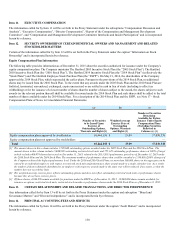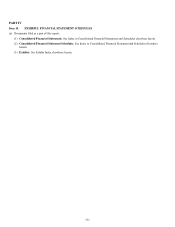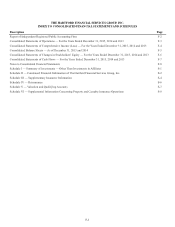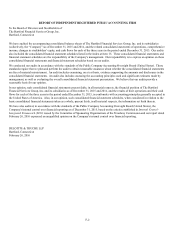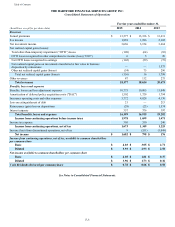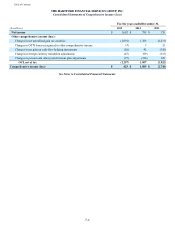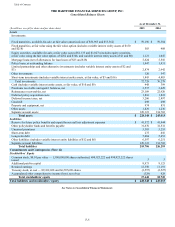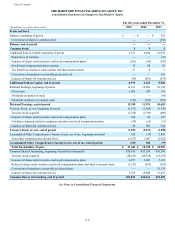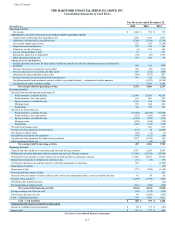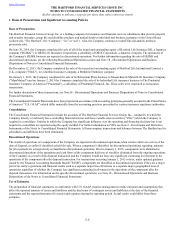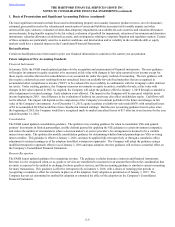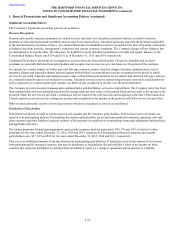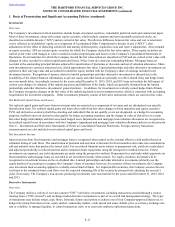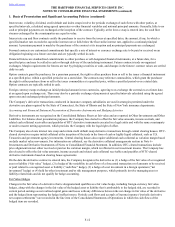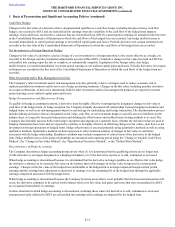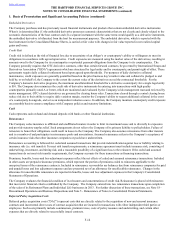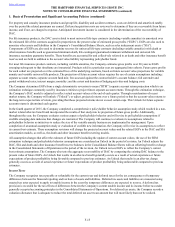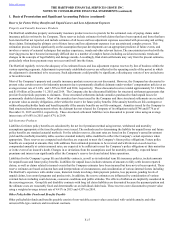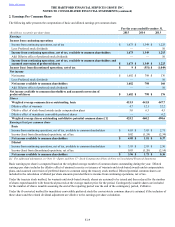The Hartford 2015 Annual Report Download - page 140
Download and view the complete annual report
Please find page 140 of the 2015 The Hartford annual report below. You can navigate through the pages in the report by either clicking on the pages listed below, or by using the keyword search tool below to find specific information within the annual report.
Table of Contents THE HARTFORD FINANCIAL SERVICES GROUP, INC.
NOTES TO CONSOLIDATED FINANCIAL STATEMENTS (continued)
1. Basis of Presentation and Significant Accounting Policies (continued)
F-9
The most significant estimates include those used in determining property and casualty insurance product reserves, net of reinsurance;
estimated gross profits used in the valuation and amortization of assets and liabilities associated with variable annuity and other
universal life-type contracts; evaluation of other-than-temporary impairments on available-for-sale securities and valuation allowances
on investments; living benefits required to be fair valued; evaluation of goodwill for impairment; valuation of investments and derivative
instruments; valuation allowance on deferred tax assets; and contingencies relating to corporate litigation and regulatory matters. Certain
of these estimates are particularly sensitive to market conditions, and deterioration and/or volatility in the worldwide debt or equity
markets could have a material impact on the Consolidated Financial Statements.
Reclassifications
Certain reclassifications have been made to prior year financial information to conform to the current year presentation.
Future Adoption of New Accounting Standards
Financial Instruments
In January 2016, the FASB issued updated guidance for the recognition and measurement of financial instruments. The new guidance
will require investments in equity securities to be measured at fair value with changes in fair value reported in net income except for
those equity securities that result in consolidation or are accounted for under the equity method of accounting. The new guidance will
also require a deferred tax asset resulting from net unrealized losses on available-for-sale fixed maturities that are recognized in
accumulated other comprehensive income (“OCI”) to be evaluated for recoverability in combination with the Company’s other deferred
tax assets. Under existing guidance, the Company measures investments in equity securities, available-for-sale, at fair value with
changes in fair value reported in OCI. As required, the Company will adopt the guidance effective January 1, 2018 through a cumulative
effect adjustment to retained earnings. Early adoption is not allowed. The impact to the Company will be increased volatility in net
income beginning in 2018. Any difference in the evaluation of deferred tax assets may also affect stockholders equity. Cash flows will
not be affected. The impact will depend on the composition of the Company’s investment portfolio in the future and changes in fair
value of the Company’s investments. As of December 31, 2015, equity securities available-for-sale totaled $839, with unrealized losses
of $2 in accumulated OCI that would have been classified in retained earnings. Had the new accounting guidance been in place since
the beginning of 2015, the Company would have recognized mark-to-market unrealized losses of $17 after-tax in net income for the year
ended December 31, 2015.
Consolidation
The FASB issued updated consolidation guidance. The updates revise existing guidance for when to consolidate VIEs and general
partners’ investments in limited partnerships, end the deferral granted for applying the VIE guidance to certain investment companies,
and reduce the number of circumstances where a decision maker’s or service provider’s fee arrangement is deemed to be a variable
interest in an entity. The updates also modify consolidation guidance for determining whether limited partnerships are VIEs or voting
interest entities. This guidance is effective January 1, 2016, and may be applied fully retrospectively or through a cumulative effect
adjustment to retained earnings as of the adoption (modified retrospective approach). The Company will adopt the guidance using a
modified retrospective approach effective as of January 1, 2016 and upon adoption, the new guidance will not have a material effect on
the Company’s Consolidated Financial Statements.
Revenue Recognition
The FASB issued updated guidance for recognizing revenue. The guidance excludes insurance contracts and financial instruments.
Revenue is to be recognized when, or as, goods or services are transferred to customers in an amount that reflects the consideration that
an entity is expected to be entitled in exchange for those goods or services, and this accounting guidance is similar to current accounting
for many transactions. This guidance is effective retrospectively on January 1, 2018, with a choice of restating prior periods or
recognizing a cumulative effect for contracts in place as of the adoption. Early adoption is permitted as of January 1, 2017. The
Company has not yet determined its method for adoption or estimated the effect of the adoption on the Company’s Consolidated
Financial Statements.


